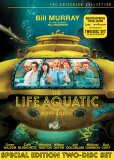| Reviews & Columns |
|
Reviews DVD TV on DVD Blu-ray 4K UHD International DVDs In Theaters Reviews by Studio Video Games Features Collector Series DVDs Easter Egg Database Interviews DVD Talk Radio Feature Articles Columns Anime Talk DVD Savant Horror DVDs The M.O.D. Squad Art House HD Talk Silent DVD
|
DVD Talk Forum |
|
|
| Resources |
|
DVD Price Search Customer Service #'s RCE Info Links |
|
Columns
|
|
|
Life Aquatic with Steve Zissou - Criterion Collection, The
Another chapter in Wes Anderson's quirky oeuvre
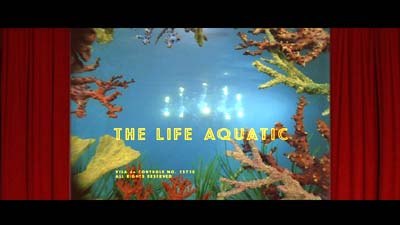
The Movie
How many directors are locks to have their films enshrined in the Criterion Collection on first release? It takes one finger to count them: Wes Anderson. He may never reach the numbers of Bergman (15 spine numbers) or Kurosawa (12), but his style is probably as close to a "Criterion style" as possible. An incredibly creative visual director with a sure handle on the subtleties of human dynamics, Anderson has no real comparison in film. Whereas Robert Altman begat P.T. Anderson (who would be a Criterion lock if his work didn't receive mainstream acceptance), there doesn't seem to be a direct line to an cinematic ancestor for this Anderson. When one considers how original his films are, in terms of both story and look, it just makes perfect sense.
Clearly inspired by the films of Jacques Cousteau, the character of Steve Zissou (Bill Murray) is an underwater adventurer sliding fast on the downside of his career. Leading his Zissou crew on the Belafonte, a rusting old submarine chaser equipped with state-of-the-'70s-art technology, he looks for new and unusual life under the sea, even if people are much less interested in watching his adventures than they once may have been. When he loses his best friend to a massive beast that may or may not exist, it pushes him to leave his science behind, and seek revenge instead.
In case you're wondering, Jaws this is not. The story will go in directions you won't predict and will introduce characters you couldn't expect. That's the key to an Anderson film: the characters. There may be a story going on that links the scenes, but it's the unique characters and how they relate to each other as people that make his movies so wonderful. When the final credit rolls by, you will remember characters with four lines just as vividly as the leads, because they were so distinctly fleshed out.
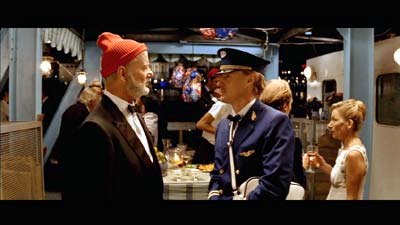
As Zissou, Murray is fabulous, creating a paradox of a man, a guy who is at the end of his rope, but refuses to accept that, even when his shortcomings are laid out in front of him by Jane (Cate Blanchett), a reporter following his every move. Were Zissou's adventures the reason that children like Ned (Owen Wilson) idolized him, or did the idol worship of the children make him the adventurer he was? Issues with identity inform most every relationship in this film, especially Zissou's two father-figure connections, with Ned, who is possibly his son, and Klaus (Willem Dafoe), who just wishes he was. When you build your life around one externally-defined aspect of your persona, you're asking for trouble, and Zissou has found it.
As good as Anderson is, without the performers that make up his troupe, this movie wouldn't be nearly as good as it is. Murray turns in another rock-solid performance in his increasingly impressive second-half career, forcing his supporting cast to raise their game another notch. Wilson responds with a nuanced performance as a man slowly putting himself together, while Dafoe is sublime as Wilson's foil, a jealous German with enough insecurity for the rest of the cast.
Outside of the Zissou daddy strife, Blanchett and Angelica Houston (as Zissou's wife) are hardly surprising, delivering the type of strong performances they have built careers around. The same goes for Jeff Goldblum, who plays Zissou's greatest foe in a hilariously over-the-top role. Add in great supporting performances by veterans Bud Cort, Michael Gambon and Seymour Cassel, and you have a dream team of actors. That Anderson is able to blend this massive cast into the film he created, while not turning smaller parts into props or stereotypes, shows just how good he is.
The Life Aquatic looks and sounds like a Wes Anderson film right from the top. Looking older than its age, thanks to choices made in film technique, costuming and set design, the film achieves a sense of timelessness, and an unusual beauty. Even little things like the fonts used in the opening titles have an effect on the overall feel of the film.
One of the more unique creative choices was the decision to create the imaginative undersea life Zissou discovers in the decidedly low-tech stop-motion animation style, calling on the master craftsmanship of Henry Selick (The Nightmare Before Christmas). They could have gone with the more integrated look of CGI, but the unnatural feel of stop-motion fits the overall tone of the movie. Anderson has such a cohesive overview of his film that nothing seems like it doesn't go together; it's all part of the story that spills from Anderson's beautiful mind.
The DVDs
As the landmark spine number 300, Criterion released Anderson's latest flick in two editions, a standard one-disc release, and a two-disc special edition. It's the first Criterion film to be released in different DVD versions (Fanny & Alexander's two releases were different films with different spine numbers), The standard release is simply the first disc of the two-disc set, while the special edition contains a disc full of bonus features and a a fold-out insert featuring a cutaway of the Belafonte, as illustrated by Anderson's brother Eric, an interview with the brothers and a chapter-stop listing. The discs are packaged in a slipcovered, single-width keepcase (with a tray), with Anderson's art on the inside cover and each platter, representing the view through a porthole, from both sides.
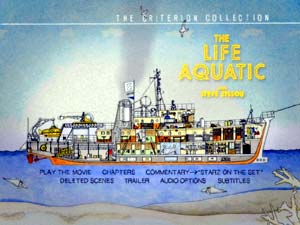
The standard Criterion full-frame menus feature subtle animation designed around Eric Anderson's art. The main menu on the first disc is the cutaway of the Belafonte, with options to watch the movie, select scenes, listen to the audio commentary, watch a featurette, view deleted scenes, watch the trailer, set-up the audio and turn on subtitles. Language options include English Dolby 5.1 and DTS 5.1, and English, French and Spanish subtitles, as well as closed captioning. The scene-selection menus feature titles for each scene. The second disc's menu is an underwater guide featuring all the extras.
The Quality
The anamorphic widescreen transfer was done digitally in high-definition under Anderson's supervision. The beautiful colors of the world of Steve Zissou are vibrantly reproduced, without a speck of dirt or damage. I've rarely seen an image so crisp and colorful. Check out the cross-section shots of the Belafonte for an example of how good this transfer is, as the constant movement and lighting changes come across without distortion.
I expected more of the audio mix, considering the disc offers DTS and Dolby 5.1, but what you get isn't half bad. The surrounds tend to carry a light ambient aspect, but occasionally they kick in harder, especially in terms of music. Surprisingly, the big action scenes don't have much in terms of audio heft. There's nothing to be upset about, as the film is mostly a dialogue-based comedy, but when you hear DTS, you expect some room-rocking sound.
The Extras
The bonus features get started right off the bat on Disc One, with a small selection of entertaining extras for those who only want the one-disc edition. A feature-length audio commentary by Anderson and his writing partner Noah Baumbach is easily the biggest extra and one of the more unique tracks in recent memory. The duo recorded the track at the same table where they wrote the film, in a restaurant in New York City. They didn't shut down the restaurant, so the effect is like sitting with the writers at dinner watching the film. It's interesting and not too annoying, though Anderson and Baumbach aren't the most electric of personalities. They do deliver plenty of info about the film and their thoughts on the process.
Nine deleted (and alternate) scenes are up next, which can be viewed one at a time or together, using the play-all option. These scenes may have been cut, but they really could have stayed in. There are some very funny moments in here, especially an expanded take with Cort's character that's so deadpan it hurts.
The nearly 15-minute behind-the-scenes featurette "Starz on the Set" is better than the usual cable-channel promo material. Done in the style of a Zissou film, it features plenty of interviews with the cast and crew, and a bundle of footage from the set, including a good amount of focus on the cross-section set. The film's theatrical trailer, which is a work of art, is also found on this disc.
The content on Disc Two kicks off with a fun and unique musical extra, as 10 full-length performances by cast member Seu Jorge are included, as filmed on the set. Brazilian Jorge translated and adapted some of David Bowie's hits, which just proves how great Bowie is. Even when you can't understand the words, the songs sound great. The songs were a big part of the feel of the movie, and it's nice to be able to listen to them in their entirety, which you can choose to do one by one or as a 40-minute set.
Three of the characters are examined in a small amount of depth, via three short featurettes. Ned, Jane and Esteban are discussed or observed during the shoot, with thoughts about their parts are shared by the actors. Similar, but longer featurettes cover the stop-motion animation used in the film, filming a scene, the production design and the costumes. In these featurettes are some wonderful off-camera moments, and they help put Murray in one hell of a favorable light, after years of stories about him being a diva. In these clips, he is light-hearted and fun.
One of the best featurettes on this collection is a 19-minute interview with composer Mark Mothersbaugh of Devo. His thoughts on how he comes up with music, his themes and his processes are fascinating and help explain exactly what a composer can bring to a film if they are truly involved in the production. The discussion about how he scored the last three Anderson films is especially interesting. On the other end of the spectrum is the "Intern Video Journal" where Anderson's former intern (who plays an intern in Life Aquatic) annoys the cast and crew with his questions and camera. It seems pointless, and tries a bit too hard to be "fun."
He probably should have taken a cue from veteran documentarian Albert Maysles, who co-directed This is an Adventure, a behind-the-scenes look at the production. How many directors have Criterion-quality directors follow them around? Maysles, joined by his co-directors on "The Gates," delivers an intimate look at the production, utilizing his very simple fly on the wall technique.
A gallery of design work that was used in the film, including the paintings and advertisements in the movie, is included for your perusal (and you should peruse) while an unbelievably deep series of photos from the set, shot by set photographer Phillipe Antonello and Anderson. Unlike your standard behind-the-scenes photos, these images are beautiful works of art. I considered capturing them to put as desktop wallpaper on my computer (and likely will at some point.) Take the time to flip through this massive gallery.
The final extra is an interview, but there's no "Charlie Rose" this time. Anderson and Baumbach stop by "Mondo Monda," an Italian talk show, hosted by Antonio Monda. The Americans have some trouble with the language, but the joke is bigger than that, and if you watch the supplements, you'll catch on quick. This is well made and very funny.
On the Hunt
There's at least one Easter Egg on each disc. Check out DVDTalk's Easter Egg section for more details.
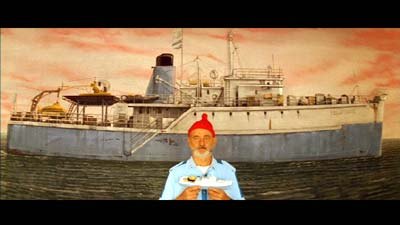
The Bottom Line
The Life Aquatic with Steve Zissou fits in perfectly with Anderson's previous work in terms of tone and character, but it is unique when compared to those movies as far as laughs go. The adventure aspects require the film to maintain a tinge of real-world seriousness that's been relatively absent in his other movies, making them more humorous than The Life Aquatic. That doesn't mean this film isn't funny. There's just more in terms of actual plot that needs to be developed. The DVD set is absolutely packed with bonus features that cover the gamut of content, from documentaries to music to faux TV clips, and the presentation of the film is flawless. No fan of Anderson's films should be disappointed, and if they are, the blame falls on them, because he's just as creative here, just working on a different kind of canvas. This DVD set is as impressive and interesting as any released for an "adventure comedy."
Francis Rizzo III is a native Long Islander, where he works in academia. In his spare time, he enjoys watching hockey, writing and spending time with his wife, daughter and puppy.Follow him on Twitter
*The Reviewer's Bias section is an attempt to help readers use the review to its best effect. By knowing where the reviewer's biases lie on the film's subject matter, one can read the review with the right mindset.
|
| Popular Reviews |
| Sponsored Links |
|
|
| Sponsored Links |
|
|
| Release List | Reviews | Shop | Newsletter | Forum | DVD Giveaways | Blu-Ray | Advertise |
|
Copyright 2024 DVDTalk.com All Rights Reserved. Legal Info, Privacy Policy, Terms of Use,
Manage Preferences,
Your Privacy Choices | |||||||









